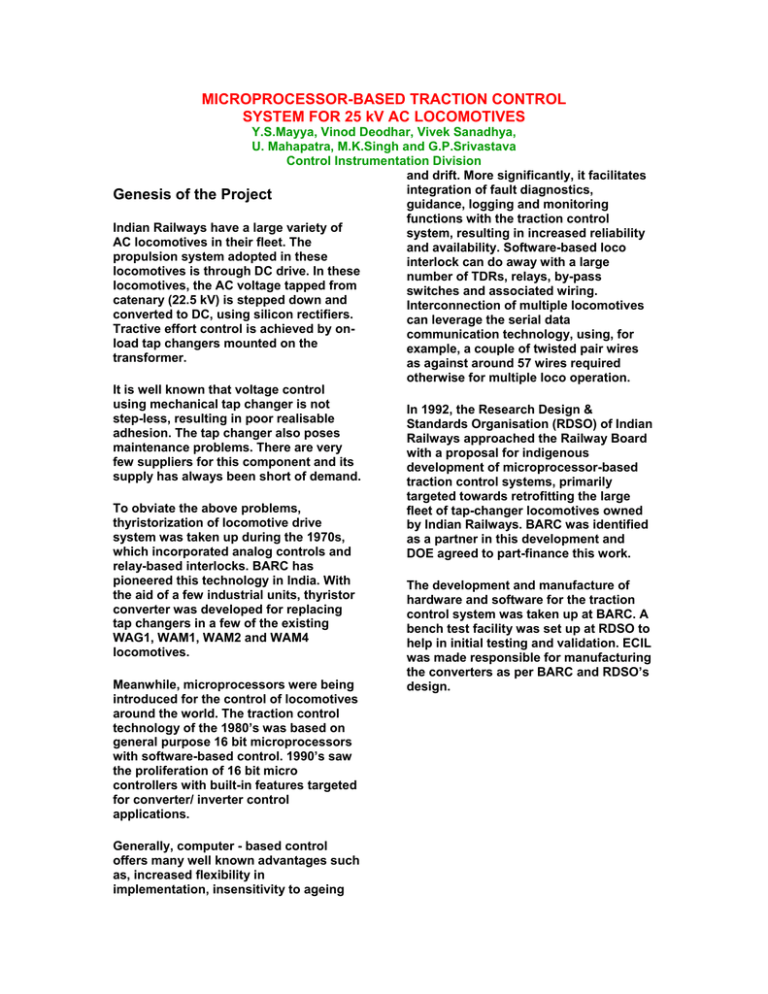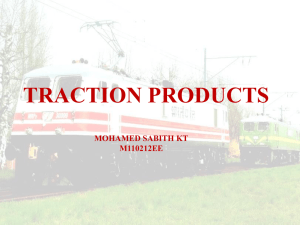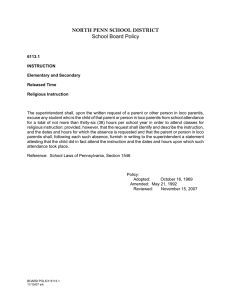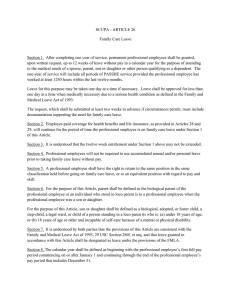Microprocessor-based traction control system for 25 kv ac locomotives
advertisement

MICROPROCESSOR-BASED TRACTION CONTROL SYSTEM FOR 25 kV AC LOCOMOTIVES Y.S.Mayya, Vinod Deodhar, Vivek Sanadhya, U. Mahapatra, M.K.Singh and G.P.Srivastava Control Instrumentation Division and drift. More significantly, it facilitates integration of fault diagnostics, Genesis of the Project guidance, logging and monitoring functions with the traction control Indian Railways have a large variety of system, resulting in increased reliability AC locomotives in their fleet. The and availability. Software-based loco propulsion system adopted in these interlock can do away with a large locomotives is through DC drive. In these number of TDRs, relays, by-pass locomotives, the AC voltage tapped from switches and associated wiring. catenary (22.5 kV) is stepped down and Interconnection of multiple locomotives converted to DC, using silicon rectifiers. can leverage the serial data Tractive effort control is achieved by oncommunication technology, using, for load tap changers mounted on the example, a couple of twisted pair wires transformer. as against around 57 wires required otherwise for multiple loco operation. It is well known that voltage control using mechanical tap changer is not In 1992, the Research Design & step-less, resulting in poor realisable Standards Organisation (RDSO) of Indian adhesion. The tap changer also poses Railways approached the Railway Board maintenance problems. There are very with a proposal for indigenous few suppliers for this component and its development of microprocessor-based supply has always been short of demand. traction control systems, primarily To obviate the above problems, thyristorization of locomotive drive system was taken up during the 1970s, which incorporated analog controls and relay-based interlocks. BARC has pioneered this technology in India. With the aid of a few industrial units, thyristor converter was developed for replacing tap changers in a few of the existing WAG1, WAM1, WAM2 and WAM4 locomotives. Meanwhile, microprocessors were being introduced for the control of locomotives around the world. The traction control technology of the 1980’s was based on general purpose 16 bit microprocessors with software-based control. 1990’s saw the proliferation of 16 bit micro controllers with built-in features targeted for converter/ inverter control applications. Generally, computer - based control offers many well known advantages such as, increased flexibility in implementation, insensitivity to ageing targeted towards retrofitting the large fleet of tap-changer locomotives owned by Indian Railways. BARC was identified as a partner in this development and DOE agreed to part-finance this work. The development and manufacture of hardware and software for the traction control system was taken up at BARC. A bench test facility was set up at RDSO to help in initial testing and validation. ECIL was made responsible for manufacturing the converters as per BARC and RDSO’s design. A WAG5 series locomotive (Loco number, 23026) was nominated for retrofitment. The locomotive was modified at Electric Loco Works (ELW) at Bhusawal and was retrofitted with the converters and controller cubicles. The testing and commissioning was started during late 1996 and was carried out in phases during many sessions throughout 1997. During March 1998, fullload line trials were conducted quite satisfactorily and all the major technical objectives of the project were realised. System Functions The Traction Control System is deployed on a modified WAG5 series locomotive which is propelled by six numbers of ~700 HP, separately excited DC traction motors, arranged in two groups of 3 motors each. Each of the motor armature is powered by a thyristor converter, which is made up of two half-bridges connected in series. The DC armature voltage isvaried by changing the firing angle to the thyristors. This is done in two-steps : in the 0 to 50% voltage range, the upper of the two half bridges is phase angle controlled and the lower half-bridge is OFF; in the 50% to 100% range, the upper bridge is fully conducting whereas the firing angle for the lower bridge is varied. This two-step sequence control improves linearity of the converter. [Figures 1, 2 and 3] The voltage (and hence current) of each of the armature converters is independently variable. But the field windings of all three motors of a group are connected in series and powered by a single field converter. This arrangement allows current sharing among motors by accommodating variations in motor characteristics and wheel diameters. A reverser in the field circuit is used to reverse the direction of field current and hence, that of the loco. During rheostatic braking, the armature converters are isolated from motors and dynamic brake resistors are connected across the armatures. The armature and field currents (Ia,If) and the armature voltages (Va) are sensed by hall-effect sensors and are used for monitoring and closed loop control. The axle speeds are sensed by pulse tachos and used for slip/ slide detection. The traction control system performs the following functions: • • • • • • Independent phase angle control for all thyristors with limits on the minimum and maximum firing angle. Two step sequence control of the armature converter with overlapped control around 50% voltage point. Closed loop control of the armature and field currents. Generation of reference (demand current) based on master controller operations, in traction and braking regions (notchingup/ notching-down). Weight transfer compensation. Automatic sequencing and control in three traction regimes : i.e. constant torque regime, constant HP regime and constant Ia/ If regime, as the loco accelerates from stand-still to balance speed. Braking effort control during rheostatic braking. etection and reduction of wheel slip during traction and wheel slide during braking. Implementation of operational and safety interlocks of the locomotive and control of various loco equipment such as panto, main circuit braker, blowers, etc. Detection of faults in the locomotive, power circuits and controller electronics, annunciation of faults and logging of faults. Support for viewing and clearing faults and for conditional bypassing of faulty equipment. Single bogie operation capability. Provision for multiple loco operation. Traction Control System Architecture In order to realise the above functions, the traction control system deploys multiple microprocessors and microcontrollers. It has a distributed and layered architecture consisting of the following five nodes which are interconnected using a master /slave network, i.e. CARNET. • • • • • Traction Control Computer-1 (TCC-1) Traction Control Computer-2 (TCC-2) Cab Interface Unit-1 (CIU-1) Cab Interface Unit-2 (CIU-2) Fault Log Unit (FLU) The following system requirements have guided the evolution of the above system architecture: • • • Redundancy considerations: Since the locomotive can be hauled using any one of the motor groups, there should be redundancy in the controllers too, so that single bogie operation is feasible. Operational requirements: Loco can be driven from master controller located in either of the cabs. The BL key identifies the currently active cab. Integrated fault logging : All faults in the loco must be logged in a unified way. Cabling considerations: Fairly large number of control and monitoring devices are located in the cabs which are required to be interfaced to the controllers. Traction Control Computers (TCC1 & TCC-2) A locomotive comprises of two bogies, each with its individual set of three motors, converters and master controller. Additionally, there are some equipment which are bogie specific and others which are common to the loco as a whole. Single bogie operation envisages a scenario wherein driver should be able to move the loco even when there are faults in one of the bogies (motors, converters, etc.). This requires redundancy in traction controller hardware. Hence, there are two Traction Control Computers - one for each bogie. TCC-1 controls motors of group-1 and TCC-2 of group-2 ( Fig. 4). While the bogie specific devices are interfaced to the corresponding TCC, the loco common devices are connected to both the TCCs. However, such common equipment should be actuated by only one TCC at a time (master), with the control switching over to the standby TCC in case of failure of the current master. The two TCCs continuously monitor the health of each other and a distributed arbitration logic grants master-ship to one of the TCCs. The common equipment are under the control of the master TCC. Each TCC is controlled by a 80286 processor which hosts all loco logics and supervisory control functions [Fig. 5]. A motor controller card with two numbers of 80C196KC - 16 bit microcontrollers is used to generate phase angle controlled thyristor trigger pulses for all 4 converters ( 3 for armatureand 1 for field) of one bogie. It also implements four current control loops - three motor armature current controllers and the common field current controller. The three processors (80286 and the two 80196) execute in close cooperation, periodically exchanging parameters with each other using a 3way bi-directional FIFO interface. [Fig. 6] Each TCC also has many binary IO cards for interfacing 110V level loco devices to the system. CAB Interface Units Each of the two cabs contains control and indicating devices which provide the driver’s primary interface to the locomotive. This includes master controller, BL key, current/ voltage meters, fault display and key-pad, etc. Normally, these devices would be interfaced to the TCCs using discrete wiring. A better alternative is to locate interface electronics at the cab itself and extend these signals to the two TCCs via serial communication links. In addition to reduction in cabling, this approach also reduces interface hardware at the TCCs. Hence, a 8044 microcontroller based Cab Interface Unit (CIU) is located near each of the cabs (Fig. 4). This unit contains isolated binary input channels (110V), analog output channels ( meters), RS232C serial port (VFD) and a few binary output channels (lamps). CIU is a CARNET slave and communicates with the TCCs through CARNET. Fault Logging and Display The traction control system integrates a Fault Log Unit (FLU) which provides services for non-volatilestorage, display and retrieval of on-line faults occurring in the locomotive (Fig. 7). This includes faults in the power circuits, loco equipment and the traction control computers. Faults are detected by the Traction Control Computers as per pre-programmed fault logics. There are two kinds of fault storage: Fault history : FLU will manage the storage of around 100 most recent faults in non-volatile memory as and when they occur in chronological order. Fault status : FLU will facilitate display of remnant faults in the system. Fault status are grouped under eight functional categories for the purpose of viewing. The driver can make attempts to clear bypass certain faults. A facility for isolating faulty equipment is also provided. The faults are physically stored in nonvolatile RAM of fault log card which is located in one of the TCC cubicles and interfaces to both the TCC and CIUs through CARNET. The faults detected by the TCC are sent to FLU as messages. Faults are displayed on each of the driver’s cab on a 6 line by 40character VFD based alpha numeric terminal (FLD). A set of 6 push-button switches are used by the driver to display, clear and bypass faults. Each cab has one set of switches and FDU and the driver can access the FLU from either of the cabs. FDU and switches are physically wired to the cab resident CIU which exchanges messages with FLU through CARNET. CARNET CARNET is the communication backbone within the loco and facilitates geographical distribution of control elements. It integrates the five nodes already mentioned. The communication requirements among these units is shown in Fig. 8. It is seen that there is a peer-to-peer message traffic. CARNET is a SDLC protocol based Master /Slavenetwork on twisted pair cable using RS485 signalling at 375 KBPS. Each of the five nodes of CARNET has a unique address. Either of the TCC nodes can become CARNET master; master-ship always rests with the active TCC. Message exchange takes place using command/response transactions. CARNET itself has a three layer architecture comprising of physical layer, link layer and message layer. The message layer is responsible for routing messages and application level protocols. The link layer is implemented by the 8044 communication microcontroller. The message layer is implemented by software and supports the exchange of application level messages. Block Control Language & Application Programming • The loco logics and control loops are programmed using function block based graphical language called Block Control Language (BCL). This tool was developed in-house and is generic enough to be useful in other projects as well. BCL allowed the technological solutions to be directly programmed in to the computer and enabled domain experts to develop and verify loco logics. It facilitated gradual, incremental addition and validation of logic and loops. • BCL has the following salient features: • • • • • • • It allows control schema to be built using binary and analog variables freely. It is independent of processor and run-time`environments (e.g., RT kernels). BCL code has deterministic execution model, e.g., single sequential task. It is extensible and customisable. All development is done on PC platforms. It leverages commercial schematic editors provided by electrical CAD software for drawing schematics. It generates ‘C’ source code and uses commercial C compilers. It supports partitioning among multiple computers and is extensible for distributed control applications. It has a large library of pre-built function blocks. The function block library consists of scores of commonly used functions encompassing combinational and sequential logic functions (gates, multiplexers, registers), arithmetic functions (adders, comparators, limiters), controllers (PI), etc. Conclusions Microprocessor-based traction control technology is one of the more complex and challenging applications of computers in real-time control. With the successful implementation and validation of this indigenously developed technology, it is now ready for retrofitting in the 25kV AC locomotives of Indian Railways, on a trial basis.




